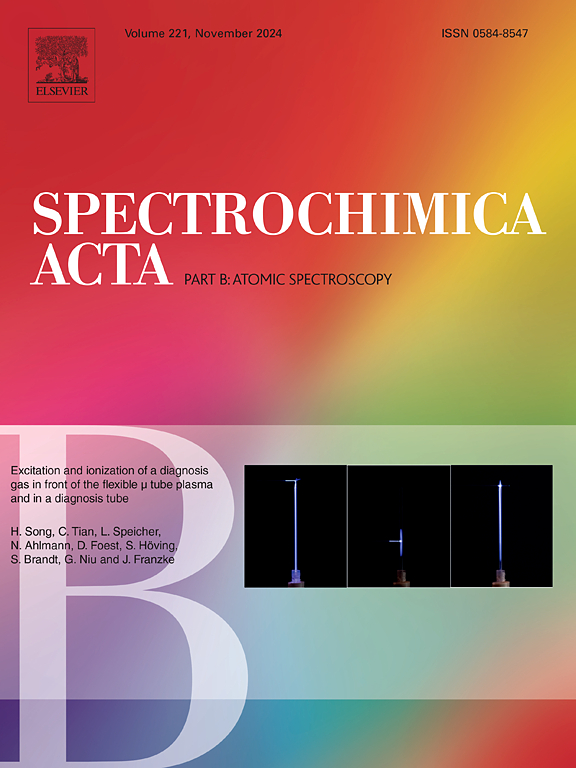Deuterium release from beryllium layers by laser induced plasma ablation and laser induced desorption coupled with quadrupole mass spectrometry
IF 3.8
2区 化学
Q1 SPECTROSCOPY
引用次数: 0
Abstract
By laser induced plasma ablation and laser induced desorption methods was studied the release of deuterium atoms contained in 1 μm beryllium layers produced by thermionic vacuum arc technology combined with a plasma torch. For such purpose was used a 1053 nm nanosecond laser source with pulse duration of 10 ns, tuned in pulse energy and repetition rate, for reaching both laser induced plasma ablation and laser induced desorption regimes. The signals of the species released from the beryllium‑deuterium layers after the laser irradiation were recorded simultaneous using a high-resolution optical spectrometer and a quadrupole mass spectrometer. In the laser ablation plasma plume, optical emission bands characteristic to BeO, BeH/BeD, H2/D2, and SiO species were identified. Mass spectra analysis revealed the dependence of released deuterium atoms on laser operating parameters.
The amounts of deuterium atoms detected by quadrupole mass spectrometry at different laser pulse energies and repetition rates, were compared with the total amount of deuterium (4 × 1017 D/m2) measured by Thermal Desorption Spectroscopy. The results indicated that 100 % deuterium atoms were released in the laser induced plasma ablation regime, in one second, at 1 kHz laser repetition rate, after samples exposure to 1000 laser pulses. In laser induced desorption regime, at 10 Hz laser repetition rate, the exposure to 10 laser pulses in one second, lead to 10 % deuterium atoms release, the percentage decreasing to 1 % when Be/D layers are irradiated with 3 laser pulses. A discussion on the heating effects of the laser beam, as function of its operating parameters, on the layer surface morphologies is also presented.

激光诱导等离子体烧蚀和激光诱导解吸耦合四极杆质谱分析铍层中氘的释放
采用激光诱导等离子体烧蚀和激光诱导解吸的方法,研究了热离子真空电弧技术结合等离子体炬制备的1 μm铍层中氘原子的释放。为此,使用了1053 nm纳秒激光源,脉冲持续时间为10 ns,调整了脉冲能量和重复率,以达到激光诱导等离子体烧蚀和激光诱导解吸两种状态。利用高分辨率分光计和四极杆质谱仪同时记录了激光照射后铍-氘层释放的物质信号。在激光烧蚀等离子体羽流中,发现了BeO、BeH/BeD、H2/D2和SiO等物质特有的光学发射带。质谱分析揭示了激光工作参数对氘原子释放量的影响。将四极杆质谱法在不同激光脉冲能量和重复频率下测得的氘原子量与热脱附光谱法测得的氘原子总量(4 × 1017 D/m2)进行了比较。结果表明,在激光诱导等离子体烧蚀条件下,样品暴露于1000个激光脉冲后,以1 kHz激光重复频率在1秒内释放100%的氘原子。在激光诱导解吸条件下,当激光重复频率为10 Hz时,在1秒内暴露10个激光脉冲,导致10%的氘原子释放,当3个激光脉冲照射Be/D层时,这一比例降至1%。讨论了激光束的加热效应,以及其工作参数对层表面形貌的影响。
本文章由计算机程序翻译,如有差异,请以英文原文为准。
求助全文
约1分钟内获得全文
求助全文
来源期刊
CiteScore
6.10
自引率
12.10%
发文量
173
审稿时长
81 days
期刊介绍:
Spectrochimica Acta Part B: Atomic Spectroscopy, is intended for the rapid publication of both original work and reviews in the following fields:
Atomic Emission (AES), Atomic Absorption (AAS) and Atomic Fluorescence (AFS) spectroscopy;
Mass Spectrometry (MS) for inorganic analysis covering Spark Source (SS-MS), Inductively Coupled Plasma (ICP-MS), Glow Discharge (GD-MS), and Secondary Ion Mass Spectrometry (SIMS).
Laser induced atomic spectroscopy for inorganic analysis, including non-linear optical laser spectroscopy, covering Laser Enhanced Ionization (LEI), Laser Induced Fluorescence (LIF), Resonance Ionization Spectroscopy (RIS) and Resonance Ionization Mass Spectrometry (RIMS); Laser Induced Breakdown Spectroscopy (LIBS); Cavity Ringdown Spectroscopy (CRDS), Laser Ablation Inductively Coupled Plasma Atomic Emission Spectroscopy (LA-ICP-AES) and Laser Ablation Inductively Coupled Plasma Mass Spectrometry (LA-ICP-MS).
X-ray spectrometry, X-ray Optics and Microanalysis, including X-ray fluorescence spectrometry (XRF) and related techniques, in particular Total-reflection X-ray Fluorescence Spectrometry (TXRF), and Synchrotron Radiation-excited Total reflection XRF (SR-TXRF).
Manuscripts dealing with (i) fundamentals, (ii) methodology development, (iii)instrumentation, and (iv) applications, can be submitted for publication.

 求助内容:
求助内容: 应助结果提醒方式:
应助结果提醒方式:


